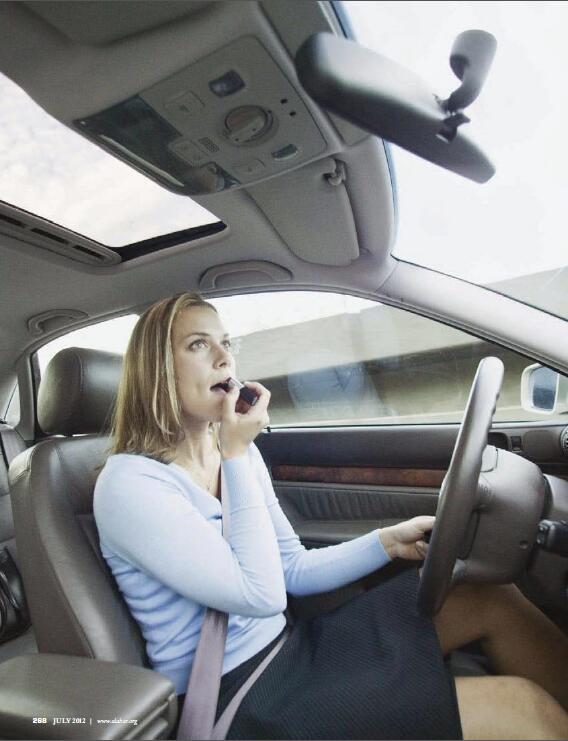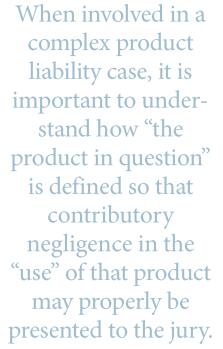Crashworthiness-based Product Liability and Contributory Negligence in the Use of the Product
| Jurisdiction | Alabama,United States |
| Citation | Vol. 73 No. 4 Pg. 0269 |
| Pages | 0269 |
| Publication year | 2012 |
By D. Alan Thomas, Paul F. Malek and John Isaac Southerland

Seventeen years ago, The Alabama Lawyer published a commentary on the state of the law in Alabama concerning contributory negligence in product liability cases.1 The focus at that time was upon the Alabama Supreme Court's decision in Dennis v. American Honda, infra., and whether the application of contributory negligence in product liability cases was "dead" in this state. The verdict at the time prompted the authors of the earlier article to quote one of Mark Twain's famous lines-namely, "The reports of my death are greatly exaggerated."
Twenty years after the release of Dennis, it is apparent that certain confusion remains. However, it appears that contributory negligence in the use of the product in an Alabama Extended Manufacturer's Liability Doctrine ("AEMLD") case should be considered-even if the contributory negligence causes the accident in question, so long as it is in the use of the product alleged to be defective.
No matter how it may be phrased, however, the concept of fault is so woven into the fabric of the AEMLD that no amount of argument should be able to separate the examination of the alleged fault of the manufacturer from that of the plaintiff in his/her use of the product. A product is still a product, and negligence is still negligence. Why then, we ask, should a jury not be allowed to consider the fault of all parties who potentially contributed to an accident or injuries when using the product alleged to be defective? The answer, as it was 17 years ago, remains relatively simple and straightforward: In AEMLD cases where there is evidence of negligence in the use of a product by a plaintiff, Alabama law requires the jury to consider that evidence.
On November 15, 1985, the Supreme Court of Alabama released its landmark decision in General Motors Corporation v. Edwards2 and adopted what was then termed "the crashworthiness doctrine."3 The Edwards opinion followed the supreme court's decisions in Atkins v. American Motors Corp.4 and Casrell v. Altec Industries, Inc.,5 which created the AEMLD and retained the "fault" concept for proving liability against a product manufacturer.6
Part and parcel of the fault-based concept under the AEMLD was the contemporaneous survival of lack of causal relation, assumption of the risk and contributory negligence as affirmative defenses.7 Indeed, as the supreme court noted, "the practical distinction, then, between our holding and the Restatement [of Torts 2d, § 402A] is that our holding will allow certain affirmative defenses not recognized by the Restatements no-fault concept of liability."8
Edwards was simply an expansion of the type of case that could be maintained under the AEMLD. Prior to that opinion, a product liability cause of action arguably did not arise without some allegation that the defect caused the incident in question to occur.9 The supreme court, analyzing the different legal views of various national jurisdictions, preferred to adopt what was deemed as "the crashworthiness doctrine," finding that it was "in keeping with the purpose of the AEMLD, which is to protect consumers against injuries caused by defective products."10 Equally important, the court's adoption of "the crashworthiness doctrine" did nothing to modify the "fault"-based concepts implicit within the AEMLD, including the availability of contributory negligence as a defense.11
Despite a singular reliance on the Restatement of Torts 2d, § 402A's "no-fault" concepts since Edwards, the Supreme Court of Alabama has reiterated on numerous occasions that contributory negligence in the use of the product alleged to be defective remains an available defense in a product liability case. Likewise, the December 2009 Alabama Pattern Jury Instructions explicitly recognize this key concept of AEMLD law, stating in the "Notes on Use": "Negligence by the plaintiff in the use of the product in question is a defense to an AEMLD claim, but plaintiff's negligence in causing the accident is not a defense to an AEMLD claim when the alleged contributory negligence does not relate to plaintiff's use of the product."12 Equally important, the updated pattern jury instructions also note that "[t]here is no distinction between 'crashworthiness' and an AEMLD design defect claim."13 Thus, under current Alabama jurisprudence, there should never be a difference between the available defenses in what some may deem a "traditional" AEMLD case as opposed to a "crashworthiness" case. Indeed, given the breadth of authority, one might think the availability of contributory negligence in any AEMLD case is well-settled law; yet, approximately 25 years after the supreme court's holding in Edwards, the debate rages on across the state.
Although some may argue that contributory negligence is "dead" in product liability, most simply try to limit its use by seeking a narrowly-tailored definition of the product in question to include only a specific portion or component part of the product as a whole. On this issue, significant precedent exists to guide the bench and bar. When involved in a complex product liability case, it is important to understand how "the product in question" is defined so that contributory negligence in the "use" of that product may properly be presented to the jury.

The Debate Begins
Dennis v. American Honda
The recognition of contributory negligence as a defense in AEMLD "crashworthiness" cases remained relatively unscathed until the Supreme Court of Alabama's decision in Dennis v. American Honda Motor Co.14 Dennis is a case where unique facts created a narrow exception. Accordingly, that opinion has little practical application in the vast majority of product liability cases in Alabama. Unfortunately, the narrow holding in Dennis is often cited for a sweeping proposition that contributory negligence is unavailable as a defense to a defendant in a "crashworthiness"-based case if the negligent act(s) relate to the cause of the accident in question, or if the negligent act(s) do not relate to the specific component and/or safety feature of the product alleged to be defective. Such assertions, however, are belied by the facts of the Dennis case and are contradictory to the basic tenets upon which Alabama product liability law is founded.
In Dennis, the plaintiff was injured when the motorcycle he was riding collided with a truck.15 The plaintiff brought claims against the helmet manufacturer and American Honda under the Alabama Extended Manufacturer's Liability Doctrine ("AEMLD") for alleged defect(s) in the helmet, not the motorcycle on which the plaintiff was riding.16
Despite its ultimate holding, the supreme court found that (under the AEMLD) certain defenses remain available to a defendant, including contributory negligence.17 However, based on the very particular circumstances of that specific case, the court held that the trial judge improperly allowed a charge on contributory negligence of the plaintiff in the use of one product (the Yamaha motorcycle) while a separate product (the motorcycle helmet being worn by the plaintiff) was the product alleged to be defective.18 In finding that contributory negligence as it related to accident causation was not available to the defendant in that case, the court stated, "[a] Plaintiffs' mere inadvertence or carelessness in causing an accident should not be available as an affirmative defense to an AEMLD action."19
The Supreme Court Clarifies The Dennis Confusion
Williams v. Delta Machinery
Following Dennis, there was, admittedly, a great deal of confusion in Alabama as to the viability of contributory negligence in an AEMLD case. In fact, the argument was made across the state that contributory negligence in product liability was "dead." In response, the Supreme Court of Alabama took the opportunity in Williams v. Delta Machinery to clarify the Dennis court's limited holding.
In Williams, the plaintiff was injured while pushing a board across an expandable dado blade.20 The plaintiff sued Powermatic and Delta Machinery under the AEMLD.21 The trial court charged the jury on contributory negligence as a complete defense to the plaintiff's claims.22 Even though the supreme court found that the plaintiff had not properly preserved an objection to the contributory negligence charge, it felt compelled to speak on Dennis because of the confusion as to that case's proper interpretation.23
Justice Houston, writing for the court, stated, "...we direct the...
To continue reading
Request your trial
